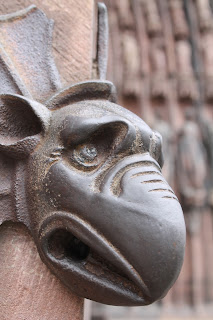France, Part 2.
On July 13, my wife and I visited the Musée Historique de
Strasbourg. On July 15, we were back in Old Strasbourg at the Place Kléber
(Kleber Plaza) and the Cathedral. What I saw at those times was immensely
moving and significant and may have been my most memorable experience in
France.
The museum documented a thousand years of history in which
Strasbourg, on the Rhine River, was nearly always consumed in war between
places that are now part of France and now part of Germany. Throughout this
time, Strasbourg thought of itself as Alsacian rather than strictly French or
strictly German. And why not? Whichever side it took, it would be conquered by
the other side within a century or two anyway. And while it was fun to dress up
in simulated medieval armor (see photo), there is no avoiding the fact that
this constant state of warfare was gruesome and entailed unmeasurable amounts
of suffering.
Most striking of all were the centuries of religious intolerance
and slaughter. Throughout most of the history of Strasbourg, as in all other
European cities, the Jews were forced to live in ghettos; near the museum you
can still walk on the Rue des Juifs, which is very narrow just as it was in
ghetto days, only it is now clean and free.
Then there was the Reformation,
when Alsace was divided up into little enclaves: Territoires passés a la Réforme
(territories becoming Protestant at the Reformation), Territories restés
catholiques (territories remaining Catholic), Zones où la Réforme a été
combattue (combat zones), and (the smallest of all) Territoires où les deux
confessions ont été tolerées (zones where both “confessions” were tolerated)
(see photo).
Inevitably, toward the end of the tour of the museum, we saw
the photos and artifacts of Nazi occupation in World War II. The French did not
simply surrender; they had a heavily fortified Maginot Line right in Alsace,
ready to defend France from a German invasion across the Rhine. But the Germans
invaded Belgium and took over France from the north, making the Maginot Line
useless. In the museum we saw a photo of Hitler standing at the base of
Strasbourg Cathedral, and of big Nazi military displays in the Place Kléber,
which they renamed Karl Roos Platz. There was even a display about brutal Nazi
experimentation on living humans. When liberation came, under General Leclerc,
the Nazi influence was swept away with great enthusiasm (see the photos).
Here is the part that meant the most to me. A couple of days
later, on July 15, when my wife and I happened by the Cathedral—there very
Cathedral where Jews were oppressed for centuries, and where Hitler walked—we saw
a klezmer band making some of the most joyous Jewish music you ever heard.
Everybody loved this Jewish music and its talented performers. Take that,
Hitler! And take that, you priests who oppressed the Jews for millennia! Right
at that moment, while the lead musician (who played my old instrument the euphonium)
was when I felt, more than ever before in my life, the joy of international
peace, the brotherhood and sisterhood of the human species.





























